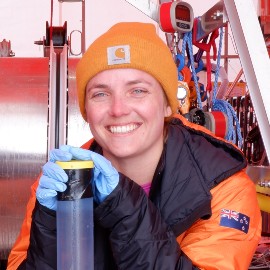Linda Balfoort

Contact
Phone: 0210 228 4763
Email: linda.balfoort@vuw.ac.nz
Office: CO509
Qualifications
BSc Victoria University of Wellington (2020)
MSc Victoria University of Wellington (2023)
PhD thesis
Title
CRISIS: Constraining past Ross Embayment Ice Sheet Instabilities from Sediment records
Supervisors
Project objectives and description
The influence of short-term fluctuations of atmospheric and oceanic conditions on the long-term variability of ice sheet mass balance remains one of the biggest uncertainties in models attempting to predict future sea level rise. The Antarctic Ice Sheet not only influences the global climate system through its control on ocean circulation and albedo, it also contains 57.9 ± 0.9 m of sea level equivalent. The concept that increasing atmospheric temperatures could cause ice thinning and, ultimately, lead to a rise in global sea levels has been understood since the 1960s, and various researchers have argued that the marine-based West Antarctic Ice Sheet (WAIS) is particularly vulnerable. Acquiring and researching sediment records from locations with ancient glacio-marine sediments can give insights into past ice sheet behaviour, thereby reducing the uncertainties about the rate and extent of future ice sheet retreat and sea level rise. Our ability to interpret the rock record in terms of ice proximity depends on our understanding of sedimentation processes in these environments, but coring sites underneath ice shelves have been relatively sparse due to often challenging working environments and thick ice cover limiting access to subglacial sediments. Moreover, knowledge of sub-km scale processes that influence glacio-marine sedimentation and ice sheet flow are poorly resolved, specifically for grounding-zone proximal environments. Ice loss models are reasonably certain within the 21st century, but become increasingly uncertain after that, especially when trying to predict the rate of ice loss. To address the uncertainty in the rate of ice sheet retreat and sedimentation processes at the grounding zone, I will combine current knowledge of glacio-marine sedimentation and provide insights from new sediment cores during the first year of my PhD to produce 1) an updated glacio-marine sedimentation model for the Ross Sector with an increased understanding of grounding-zone proximal processes, and 2) an updated post-Last Glacial Maximum (LGM; ~129-116 kyr) ice retreat model for the Ross Sector. During the LGM the WAIS grounding line striked approximately east-west, extending across the continental shelf as far north as 74°S, but retreat to its current position is postulated to have been highly non-linear and evidence is primarily derived from sediment cores collected off the continental shelf or from remote sensing.
The Sensitivity of the West Antarctic Ice Sheet to 2°C warming (SWAIS-2C) project collected seven short (<2 m) soft sediment cores from underneath the Ross Ice Shelf at the Siple Coast (Lat. 82.6285’S, 156.3046’W), West Antarctica. Our coring location adds to the existing ~10 locations where sediment records have been collected from underneath the ice shelf, and preliminary on-ice X-rays revealed possible WAIS retreat sedimentary sequences and an intact and extended grounding-zone proximal section. These cores have the potential to further restrain both grounding-zone proximal sedimentation processes, as well as post-LGM ice sheet retreat in the Ross Sea Sector, further aiding our understanding of the mechanism and rate of ice retreat.
During the 2024/2025 austral season, the SWAIS-2C team will return to the Siple Coast to collect a 200-m-long sediment core. The second year of my PhD will therefore focus on 1) applying the sedimentation model I produced during the first year of my PhD to ancient glacio-marine sediment cores and 2) provide further evidence (or lack thereof) for past ice shelf collapse events under warmer-than-present climatic conditions.
